Graphene: 20 years of a 'miracle' made in Manchester
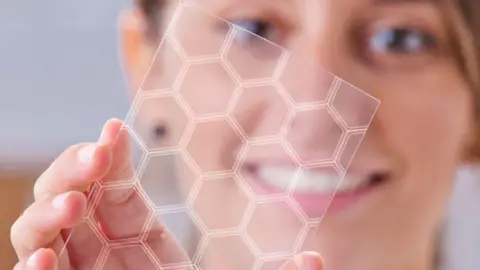 Getty Images
Getty ImagesTwo decades ago, two scientists were playing around with sticky tape on a Friday night when they discovered the "miracle" material that went on to earn them a Nobel Prize.
Graphene, a single layer of carbon atoms said to be the thinnest and strongest substance ever recorded, was hailed as a gamechanger after Prof Konstantin Novoselov and Prof Andre Geim revealed it to the world in 2004.
It was claimed the material, discovered by the pair at the University of Manchester, would make a reality of technology only seen in science-fiction.
Twenty years on, researchers like Professor James Baker say we are now approaching "tipping point" where graphene will start to live up to the hype.
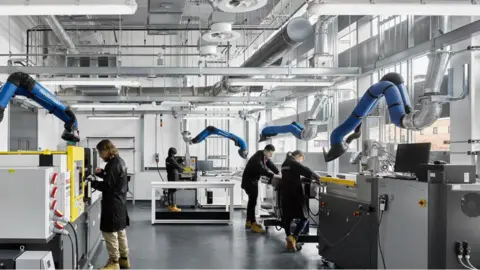 UniversityofManchester
UniversityofManchesterGraphene is a single atomic layer of graphite, the carbon mineral found in the tip of pencil, arranged like honeycomb in a hexagonal lattice.
Stronger than steel and more conductive than copper, the flexible material is so tiny scientist have described it as the word's first two-dimensional material.
It has been tested for use in products like brain implants, water filters, touchscreen technology and even roller-skating rinks.
"There's hardly any area of technology that it couldn't enhance," said Sarah Baines, curator of engineering and Manchester's Science and Industry Museum.
She said although the theoretical basis for graphene had been established, until 2004 no one had been able to isolate "the elusive single layer".
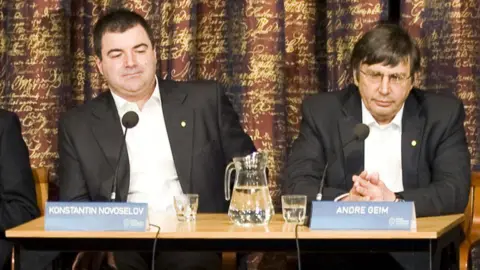 Getty Images
Getty ImagesGeim and Novoselov, two physicists born in the Soviet Union, held regular experiments on Friday nights where they would try and come up with creative ideas to old problems.
"The story goes the research team were using sticky tape with graphite," Ms Baines said.
"Someone said, 'Are we throwing away pieces of graphene?'
"They fished the tape back out of bin and put it under microscope and were astounded to see really thin flakes of graphite."
The story features in a exhibition at a festival on the theme of extreme materials being held at the museum.
"You don’t get more extreme than graphene: the smallest, most-conductive, strongest, most flexible, most extreme material you can think of," Ms Baines said.
Geim and Novoselov won the Nobel Prize in 2010 for the discovery, but the challenges of manufacturing the material at scale mean it has not exploded on to the scene in the way initially expected.
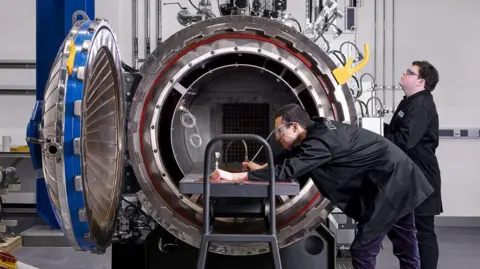 UniversityofManchester
UniversityofManchester"There was a lot of hype when graphene first came out and people expected things to happen very quickly," Prof Baker said.
"At twenty years young, it's still a new material, so we haven't got all the answers for every market case, every opportunity," he added.
But the University of Manchester professor feels a "tipping point" is approaching as researchers now "know how to make it work and we know how to make it work affordably".
For example, as little as 0.1 per cent of graphene placed into a material like rubber or concrete can make a "really significant difference", he said.
"So traditionally, we think of a new material like graphene as costing you more, but there are many use cases now where actually it costs less."
And scientists have now also worked out to scale up production.
It's no good making graphene by the gram or the milligram. We need to make it by the kilo, by the tonne, by the 100 ton," he said
"And the good news is now you can."
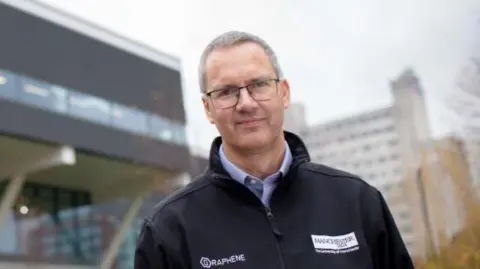 UniversityofManchester
UniversityofManchesterProf Baker oversees work at the Graphene Engineering Innovation Centre, which helps companies help translate the science behind graphene into commerical technology.
It is part of the £13m National Graphene Institute, opened by the University of Manchester in 2015.
"One of the challenges around new materials as people expect them to come to market very quickly," Prof Baker said.
"However, if you look at past new materials like carbon fibre or silicon that you see in everyday life, it was probably 25 to 30 years from discovery through to the first products in the marketplace."
But, he said, the time will come when "people will find that graphene starts to touch their lives".
Listen to the best of BBC Radio Manchester on Sounds and follow BBC Manchester on Facebook, X, and Instagram. You can also send story ideas to [email protected] and via Whatsapp to 0808 100 2230.
